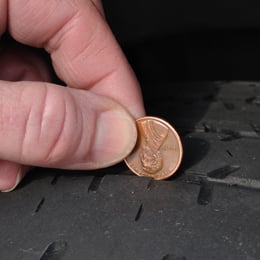 If you've been to Road America in Elkhart Lake, WI, to watch a race, you know how beautiful and thrilling the race track is. When I was there, I was able to go out on the track as a passenger in a ZR1 Corvette. The speed and power of the Corvette was astonishing.
If you've been to Road America in Elkhart Lake, WI, to watch a race, you know how beautiful and thrilling the race track is. When I was there, I was able to go out on the track as a passenger in a ZR1 Corvette. The speed and power of the Corvette was astonishing.
As we headed down the back straight away, I asked the driver how fast we were going. His answer was 135 mph! As we approached turn five, he also told me that this is the part of the racetrack where most cars go off the track. At that instant, it dawned on me how essential tires are.
Think about it. Driving is one of the most dangerous things we do in our lives. We rely on four tires with a contact patch the size of our hands to keep us traveling down the road safely. So keeping our tires in good shape is important!
Here are some tips to help you do that.
1. Check your tire pressure monthly.
Tires can lose approximately one pound per square inch of air (PSI) per month, and they can lose even more in cold weather climates. So, relying on your mechanic to check your tire pressure only at oil changes or tire rotations could put you and your family at risk.
According to the National Highway Traffic Safety Administration, underinflated tires are the leading cause of tire-related crashes. Underinflated tires decrease vehicle handling and gas mileage and can lead to premature tread wear and a catastrophic blowout. Tires are expensive, but by checking your tire pressure regularly, you can extend their life. To find the appropriate tire pressures for your car, check your owner’s manual or the placard on your door frame.
2. Inspect tires regularly, especially before long road trips.
When you’re checking tire pressure or washing your car, physically inspect your tires. Don’t be afraid to get down on your hands and knees to do your inspection. Things to look for include cracks, bulges, and objects that may have punctured the tire, such as nails, screws, glass, or stones. If one of these objects punctures the sidewall of your tire, your tire will need to be replaced.
If you’re going on a long road trip, check your tire pressure and inspect your tires before you leave home. It’s much easier to inspect your tires in the safety and comfort of your garage or driveway than on the side of the freeway with cars zipping by at 65mph or faster.
If you experience a tire failure while traveling, consider calling a tire professional in that area to help you change or replace your tire.
3. Rotate, rotate, rotate.
To maintain even tread wear and maximize tire life, it’s recommended that you rotate your tires every 6,000 to 8,000 miles. If you buy a set of tires from your local tire store, they may provide free tire rotation. If they don’t, tire rotations are relatively inexpensive.
4. Don’t overload your vehicle.
Located on the placard on your door frame is information on how much weight your vehicle can safely handle. Overloading a car can also cause tire failure.
In high school, I overloaded my parents’ Cutlass Supreme station wagon. While the tires didn’t blow, the car's handling was affected.
5. Don’t wait until your tires are on their deathbed to replace.
In my early married life, I drove my car around with the steel radials coming through the tire; yes, even on the highway.
Tires are expensive and not fun to buy; however, driving on your tires past their useful life puts you and your family in danger.
Most tires have a wear bar between the treads. If the tread depth is at or below this bar, it’s time for new tires. Another trick I learned is to use a penny to check tread wear. Turn the penny upside down so Abraham Lincoln’s head is between the tread. If you can see the top of Honest Abe’s head, it’s time for new tires.
6. Don’t install mismatched tires.
After some research, I learned that mismatched tires can negatively impact a car's handling and cause unusual wear and tear on the rest of the vehicle's components.
The rule of thumb for buying tires is to always buy at least two and put them on the rear of the car no matter what type of car you own. While I was taught you should always put new tires on the front of the car, the benefit of putting the new tires on the rear is better handling under wet conditions. If there are poor tires on the rear of your car, it could cause a spin-out.
Do you have any suggestions or information you’d like to share? I’d love to hear from you. Please share them in the box below.





